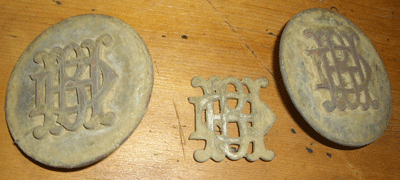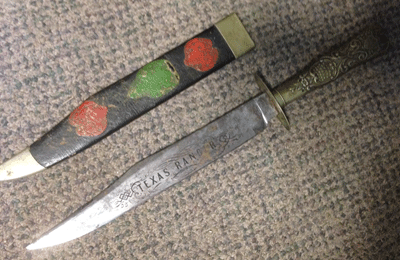|

|

Posted September 2014

|
If you have a Civil War item that you can't identify or something you want to know the value of, contact John (mail: Box 510, Acworth, GA 30101;
email John at seantiquing@go-star.com with
Civil War in the subject
line or call 770-329-4984 or 770-974-6495). John needs a good description of the item, condition, manufacturer's marks and any other markings, and photos.
Please Note: All questions MUST be accompanied with a Photo, it should not be more than 200k in file size.
|
|
|
|
I am contacting you to try and figure out who might have carried these items to battle, as well as determining a rough value of my finds. Back in the ‘80s, I attended Longwood College located in Farmville, Va. We had the luxury of all these great battles nearby, and a few of my fraternity brothers got involved in relic hunting. We hit Sailor's Creek, Sandy River, Rice, High Bridge, Jamestown and Cumberland Church and then we went out Airport Drive towards Appomattox.
A couple items stand out in my collection. They are solid lead/brass disks about the same size and weight of breast plates, silver-plated with brass initials that are punched through disks and bent on the rear to hold to the disks. On the rear are strap attachments like rosettes I have seen. These are much nicer than any sets I have seen. Dave Wilson, a local Civil War expert, has seen them, and he feels they were owned by a Confederate officer. Any ideas on identifying this man?
|

|
Large, custom-made, monogrammed Civil War bridle rosettes lost by an unknown owner.
|
They were found in relation to the Battle of Cumberland Church where the South was about to give up its notion of heading north and figured their only way was west. These items were found on superior real estate, high ground with Union stuff all over the hillside where they charged this high ground and shot uphill at Confederates on top. The South repulsed this attack, probably the last little victory before it all caved in.
I feel the story behind the items to be a large part of what makes the piece interesting. What makes these items so special to me is that we had combed this area for weeks, and everyone felt it had given all it had, but I decided to return one more time. I am glad I did. These were meant to be recovered, and I have enjoyed them and would like to figure out who he was. Obviously, he was a man of means; not everyone owned such items of display.
JS: Nice group of relics you found of bullets, belt hardware, coins and so on. The bridle rosettes are most unusual. Monogram types like those are more typical with tin backs or iron and post Civil War. They are especially numerous in the West, but the lead solder-filled types are Civil War Era. The initials no doubt stood for their owner. If they could only talk and tell us who they were worn by. They were no doubt expensive in their day, and the owner had them made to show off. They are indeed almost twice the size of traditional rosettes, circa 1860 also.
As far as value, that's tough to say. Similar ones from out west rarely sell for more than a few hundred dollars (unless belonging to a prominent personality), and many can be bought for less. Few custom-monogrammed Civil War rosettes have turned up, and if identified with a prominent figure from that particular cavalry fight, who knows, they could be worth maybe $1,000-$2,000.
|
|
|
I wonder if you could help me identify an old knife I found in my mother-in-law’s stuff. I think it is a souvenir knife, but I don't really know for sure. The blade is marked “Texas Rangers.” Any information you could provide on its age and value would be very helpful.
JS: Your knife is circa 1850 and made by Samuel Wragg of Sheffield, England, for the American market. Wragg is among the best-known and prolific makers circa 1840-1860. This is the third or fourth example known to the Bowie knife collecting community if this exact pattern.
|

|
Circa 1850 “Texas Rangers”-engraved Bowie knife, $3,000-$5,000.
|
The knife appears as found and is no doubt original and authentic, as other examples are the exact configuration with the same patriotic cutlery handle with drooped-wing eagle motif in the pommel. Your handle is a bit bent, but the scabbard is perfect, with German silver mounts and original frog button intact. It will display beautifully. The 9-inch blade made this a menacing weapon, no doubt.
"Texas Ranger" is the real value in this knife; it is a rare motto on Bowies (authentic examples). Two have been sold or offered in auction. The last was at Heritage Auction Galleries offered as lot 52078 on June 26, 2010. That knife was from the famous Norm Flayderman Collection. The presale estimate was $20,000-$25,000 with a reserve of $16,000, and it did not sell. That example was indeed nearly pristine with no defects, and if estimated lower, it may have sold for $7,000-$8,000 in my opinion. Condition is the key, and when you have rarity and condition, you never know what might happen in an auction.
Since that time, there was another example sold at an auction I attended in California. It was cataloged as a fake etching, which it was not in my opinion. It lacked condition and still sold for more than $2,000.
Your knife has "the look," being untouched with a perfect scabbard, fine frosted blade with rich grime, soiling—the patina so desired among collectors that just can't be faked. If I were cataloging your knife for auction, I would place a presale estimate of $3,000-$5,000 and know it would bring that range, but I would not be surprised to see it bring $6,000-$7,000.
|
|
|
As far as I know, George K. Griggs was a colonel in the 38th Virginia Infantry. It records the time period between June 2nd, 1861 and August 1st, 1865 with daily entries through most of the diary. In the attachment, you will see that I sent you the pages from Gettysburg and a page where he looks to have copied R. E. Lee's farewell address at Appomattox. Please let me know what you think.
JS: Diaries from the Civil War are among the most common artifacts surviving. Value is determined by aesthetics of the diary itself, but most important is the content. Your diary is most unusual in that it's written by a high-ranking officer, Col. George K. Griggs of the 38th Virginia Infantry and has great detailed content spanning the entire war from June 1861 through Appomattox and several months thereafter. The size is larger than most pocket diaries of the day, but officers were able to carry more personal items such as this. His transcription of Robert E Lee's "General Order No. 9" in the back of book is also a nice addition.
The 38th fought in many battles of the Army of Northern Virginia and was part of General George Pickett’s division when at Gettysburg. It was part of the fabled "Pickett's Charge" where casualties to Confederate soldiers were devastating. Griggs in his diary details the charge of the division on July 3, though not mentioning Pickett by name, and telling of a painful flesh wound where a mini ball pierced his thigh. Most Confederate diaries sell for no more than $2,000–$3,000, though there are a few exceptions that have brought more than $10,000. To realize the best price in my opinion, this diary should be sold at auction. There are several very good national and international auctions that market such material. There are several New York auction houses that have rare book and manuscript sales that this might fit in with, and Wes Cowan has an excellent reputation for selling important Civil War paper items at his auction in Cincinnati, Ohio.
|
|
|
John Sexton is an independent appraiser and expert of Civil War memorabilia. He is an accredited member of various appraiser organizations. He can be contacted at 770-329-4984 or www.CivilWarDealer.com. If you have a Civil War item for him to appraise, email a photo and a description to seantiquing@go-star.com
.
|
|
|
|
|
|
|
|